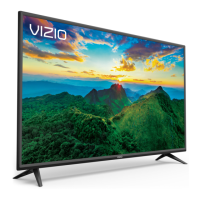
Do you have a question about the Vizio D43-F1 and is the answer not in the manual?
| Screen Size | 43 inches |
|---|---|
| Smart TV | Yes |
| HDMI Ports | 3 |
| USB Ports | 1 |
| Wi-Fi | Yes |
| Smart TV Platform | Vizio SmartCast |
| Backlight Type | LED |
| Refresh Rate | 60 Hz |
| Ethernet Port | Yes |
| Bluetooth | No |
| Resolution | 4K UHD (3840 x 2160) |
| Voice Control | Yes |
| HDR Support | HDR10 |
Essential safety guidelines for operating and maintaining the VIZIO TV to prevent hazards and ensure proper use.
Ensures proper grounding for antenna/cable systems to protect against voltage surges and static charges.
Details the components and indicators located on the front of the VIZIO television, including the remote sensor.
Identifies and explains the purpose of various ports and connectors on the rear of the TV for external devices.
Guidance on safely mounting the VIZIO TV to a wall, including screw size and hole pattern specifications.
Explains the functions of each button on the VIZIO remote control for TV operation and navigation.
Step-by-step instructions on how to open the remote and replace the batteries correctly.
Guide to accessing and navigating the TV's on-screen menu system using the remote control.
Instructions on how to select different connected devices like Blu-ray players or game consoles.
How to adjust picture display modes (Normal, Panoramic, Wide, Zoom) for optimal viewing.
Detailed guide on modifying picture parameters like brightness, contrast, color, and picture modes.
Fine-tuning picture settings such as detail, noise reduction, and color temperature for better image quality.
Creating, saving, locking, and resetting custom picture modes for personalized viewing experiences.
Procedures for deleting or resetting custom picture modes to default factory settings.
Adjusting HSB color settings and 11-point white balance for precise color calibration.
How to show or hide SMPTE, Flat, and Ramp test patterns for display calibration.
Using the uniformity analyzer test pattern to check screen consistency and identify display issues.
Guide to configuring audio parameters like speakers, surround sound, volume leveling, and digital audio output.
Steps to connect the TV to a Wi-Fi network by selecting the SSID and entering the password.
Advanced settings for manual IP, DNS, and gateway configuration.
Locating the TV's MAC addresses for network setup and security configurations.
Instructions for connecting to a wireless network whose SSID is not broadcast.
Verifying the TV's network connection status, signal strength, and download speed.
Configuring sleep timers for automatic TV shutdown and auto power off features.
Performing an auto channel scan to find available over-the-air or cable channels.
Removing unwanted or weak channels from the channel list using the Skip Channel feature.
Selecting different audio languages or SAP for analog and digital broadcasts.
Managing content access based on TV ratings by enabling or disabling program rating features.
Preventing children from viewing specific channels by locking or unlocking them with a PIN.
Using the rating block feature to restrict viewing of content based on its rating category.
Customizing the display of digital closed captions, including text style, size, color, and background.
Accessing technical data and status information about the TV and its network connection.
Changing the language displayed in the TV's on-screen menus.
Setting the TV's time zone, daylight savings, and country for accurate time display.
Enabling control of connected HDMI devices via the TV remote using CEC functionality.
Choosing between Eco Mode and Quick Start Mode for power consumption and startup speed.
Assigning a unique name to the TV for easier identification among other devices.
Resetting the TV to its original factory settings, clearing all user configurations and data.
Turning the front panel power indicator light on or off.
Setting and managing a system PIN for picture mode lock, parental controls, and factory reset.
Introduction to SmartCast TV, its features, and capabilities for streaming and content discovery.
Methods for accessing and starting the SmartCast TV interface using the remote or inputs.
Requirements for formatting USB drives and saving media files for playback on the TV.
Connecting a USB drive, selecting content, and safely removing it from the TV.
Navigating the music player, viewing track information, album art, and controlling playback.
Browsing and playing video files from a connected USB drive, including file information.
Viewing photos from a USB drive, including slideshow options and photo information.
Solutions for common issues like remote unresponsiveness, no signal, no power, and image problems.
Addressing specific issues like screen noise, input size changes, app downloads, and Wi-Fi connection.